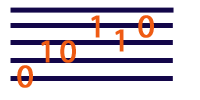WebAudio and WebMIDI Experiments
Support for the Web Audio API is not the same in all browsers. If you have trouble playing the examples, try using Chrome.
Use an AudioWorklet to generate a custom sound using JavaScript.
The AudioContext must be started by a user gesture so use some buttons.
Here is the source code for the NoiseGenerator.
class NoiseGenerator extends AudioWorkletProcessor {
// Custom AudioParams can be defined with this static getter.
static get parameterDescriptors() {
return [{ name: 'amplitude', defaultValue: 1 }];
}
constructor() {
// The super constructor call is required.
super();
}
process(inputs, outputs, parameters) {
const output = outputs[0];
const amplitude = parameters.amplitude;
for (let channel = 0; channel < output.length; ++channel) {
const outputChannel = output[channel];
if (amplitude.length === 1) {
for (let i = 0; i < outputChannel.length; ++i)
outputChannel[i] = ((Math.random() * 2.0) - 1.0) * amplitude[0];
} else {
for (let i = 0; i < outputChannel.length; ++i)
outputChannel[i] = ((Math.random() * 2.0) - 1.0) * amplitude[i];
}
}
return true;
}
}
registerProcessor('noise-generator', NoiseGenerator);
